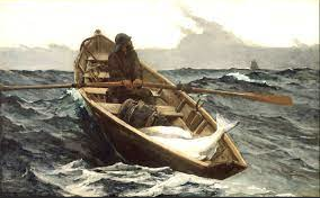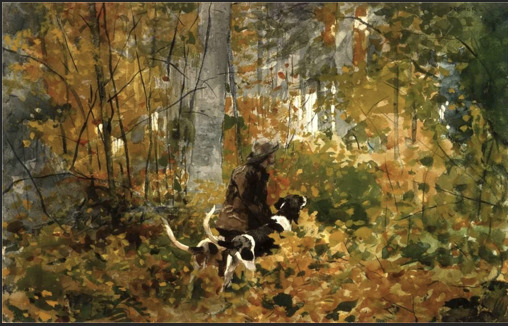The American landscape painter and illustrator Winslow Homer (1836–1910) is best known for his marine subjects. Although he didn’t receive formal art education, he began his career as a commercial illustrator. Later, he started with oil painting and also worked in watercolor.
Homer had a very interesting life and career and created many oil paintings on canvas and watercolors in different mediums. He even experimented with etching. In this article, we’ll learn all about artist Winslow Homer – his life and general aspects of his works of art. Then we’ll look at a few of the famous Winslow Homer paintings.
Early Life
Winslow Homer’s mother, Henrietta, was a very talented watercolor artist, and Winslow received his first lessons on how to use colors from his mother. He and his mother had a close relationship throughout her life.
According to art critics, many of the characteristics in Henrietta’s works can also be found in Winslow’s works. He inherited, for instance, not only her strong-willed nature but also her quiet and friendly traits. However, according to art historians, the best characteristics he received from his mother were her dry sense of humor and her artistic eye, and they contributed to the amazing Winslow Homer artworks.
Winslow had a happy childhood, and his mother encouraged him to develop his artistic talent, which was evident when he was still very young. Art scholars speculate whether his memories regarding his good childhood played a role later in his decision to depict simple farm life and rural environments in his paintings.
Beginning of his Career
Homer established himself as an illustrator when he was 21 years old. He chose to freelance for publications such as “Harper’s Weekly” rather than work for only one employer.
During the Civil War, he went to the Virginia front several times and created unique illustrations, regarded as the best graphic of that time. They were sought after because of their realism, design, and draftsmanship.
Basic Characteristics of Homer’s Painting Style
When you check out Winslow Homer watercolor paintings you’ll find that he always worked on natural visual sensations of outdoor color and light. He strongly disregarded the traditional ways of using light.
His illustrations were also always based on direct observations of nature. In addition, he had the talent to combine color, pigment, and line qualities with a fresh vision.
During the later part of the 1800s, Homer started to use watercolors. Unfortunately, he had so much success with watercolors that he left illustrations after 1875 and only created a few more illustrations.
Winslow’s Last Years
Homer left New York in 1883 to live all on his own on the Maine coast, where he built a studio and stayed for the rest of his life.
This was when the famous painter Winslow Homer seascapes paintings were created. In fact, he loved to paint sailors, fishermen, and hunters. He also frequently depicted the forests and mountains of the area.
For the last part of his life, the main subject of his paintings was the sea. His favorite theme was stormy oceans. Art critics describe the period as the time when he depicted the sea and the shore as a “battlefield” of waves and rocks. When you view his sea paintings, you experience the waves’ movement, the rocks’ sturdiness, and the collision of the water and the rocks.
In the late 1890s, he spent most winters in the Bahamas, Bermuda, or Florida, where a new world of light and color was revealed to Homer, the artist.
Three Oil Paintings by Winslow Homer
Let’s now have a closer look at three of Homer’s famous oil paintings.
Prisoners from the Front
“Prisoners from the Front” was painted by Homer in 1866 and is one of his most notable early works. It depicts Confederate officers surrendering to Union Brigadier General Francis Channing Barlow during the American Civil War. This work was inspired by Homer’s visit to the war zone as corresponded.
Interestingly, infrared photography and studies indicate that the painting underwent many changes before it was finally completed.
A Visit from the Old Mistress
Art historians believe that this 1876 painting is one of several works that Homer created during a visit to Virginia. Many art scholars believe that the painting’s composition is taken from the abovementioned painting, “Prisoners from the Front.” “A Visit from the Old Mistress” is one of Homer’s paintings of black southern life of that time and is deemed an invaluable record of life in Virginia during the Reconstruction.
The Fog Warning

The Fog Warning Painted by Winslow Homer
“The Fog Warning” is one of several famous paintings on marine subjects by Winslow Homer. The painting depicts the hard lives of fishermen in Maine and is an excellent example of the Homer artist’s decision to depict simple life and rural environments in his paintings.
Three Watercolors by Winslow Homer
Now that we’ve briefly learned about Winslow Homer’s paintings let’s check out Winslow Homer’s watercolors.
Boys in a Dory
“Boys on a Dory” was created by Homer in the mid-19th century and is one of his first watercolors painted on woven paper. A group of boys boating in a dory is the subject of this famous painting. It is an example of Homer’s decision to depict simple life and rural environments in his paintings.
On the Trail

On the Trail Painted by Winslow Homer
“On the Trail”, a watercolor of deer hunters in the Adirondacks, is an example of works depicting the sport. As background, it is good to know that at that time, one method of hunting was called hounding.
With hounding, dogs tracked and chased the deer. Finally, the hunter entered the forest with his belt of hounds and unleashed them one by one. The deer instinctively took to the water to get away from the dogs, and the hunter waited in a boat and overtook the deer once it had entered the water and then shot or clubbed the deer.
In On the Trail, a young hunter holds two dogs whose tails are twitching with excitement.
Hound and Hunter
“Hound and Hunter” is another watercolor in Homer’s series on hounding. It depicts a young hunter lying in a guided boat. He holds a noose in one hand and a dead deer in the other while his gaze is fixed on the dog swimming toward him.
The young hunter’s unsteady footing in the boat conveys to the viewer an image of a man who is not entirely sure what he is doing.
Conclusion
Although the famous painter Winslow Homer was, to a great extent, a self-taught artist, he is considered one of the best American painters of his time.